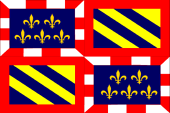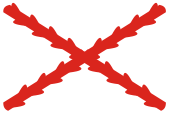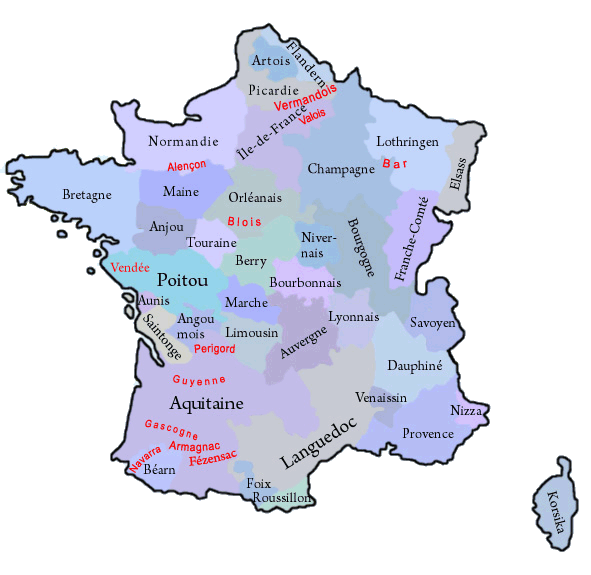mobile View, to the German Version tap the flag


- historical region in France
- former kingdom, duchy and province
- French: Bourgogne
• Flags
• Meaning/Origin of the Flag
• Coat of Arms
• Meaning/Origin of the Coat of Arms
• Map of the historical Regions in France
• Explanations about the Regions
• History
• Origin of the Country's Name

Flag of Burgundy
– Drapeau de la Bourgogne,
Source, by:
Wikipedia (DE)






ca. 1370–1477,
Flag of Burgundy
– Drapeau de la Bourgogne,
Source, by:
Wikipedia (FR)




1960–2016,
unofficial flag of Burgundy Region
– drapeau officieux de la région Bourgogne,
Source, by:
Wikipedia (DE)






The flag of Burgundy is a scutcheon-flag, its design is the image of the coat of arms of the of the House of Junior Line of Burgundy. The with this connected heraldry shows a bunting that is quartered as the coat of arms. The flag shows two times, in field 1 and 3, the heraldry of the Senior House of Burgundy (1031-1361), a sixfold between gold and blue oblique-right divided shield, which is surrounded by a red border; and the flag shows two times, in field two and four, the heraldry of Touraine, the blue, with golden lilies topped shield of the Capetians, which was surrounded by a red and white border. Especially the House of Junior Line of Burgundy used in his extensive estates (except Burgundy itself belonged among others to it: Artois, Nevers, the Franche-Comté, Flanders, Brabant and Holland) and also at sea a simpler flag, which was easyer to produce and better to recognize, a white flag with a red bough cross. When the Netherlands became a possession of the Spanish line of the Habsburgs, the bough cross found its way into the design of many Spanish flags, e.g. in Basque Country or in the American Vice-Kingdoms. The between 1960 and 2016 existing Region of "Bourgogne" (Burgundy) used an unofficial flag, which – like the historic flag – showed the features of the heraldry of the House of the Junior Line of Burgundy.
Source:
Volker Preuß,
Wikipedia (D)


Coat of arms of the Duchy of Burgundy under the House of the Senior Line of Burgundy
– Blason du Duché de Bourgogne sous la Maison de la Ligne Principale de la Bourgogne,,
Source, by:
Heraldique Europeenne

Coat of arms of the Duchy of Burgundy under the House of the Junior Line of Burgundy
– Blason du Duché de Bourgogne sous la Maison de la Ligne Récente de la Bourgogne,
Source, by:
Heraldique Europeenne

The oldest known coat of arms of Burgundy is that of the Senior Line of the House of Burgundy. It shows a sixfold between gold and blue oblique-right divided shield, which was surrounded by a red border. The Senior Line of the House of Burgundy goes back to the Capetians. It ruled Burgundy from 1031 to 1361. This dynasty was born, as Robert II., King of France, passed the Duchy of Burgundy in 1031 as an appanage to his second son Robert. With the death of Duke Philip I. the Senior Line of the House of Burgundy extincted. The most famous coat of arms of Burgundy is that of the Junior Line of the House of Burgundy. It is quartered and shows shows two times, in field 1 and 3, the heraldry of the Senior House of Burgundy; and it shows two times, in field 2 and 4, the heraldry of Touraine, the blue, with golden lilies topped shield of the Capetians, which is surrounded by a red and white border. The Junior Line of the House of Burgundy goes back to the Valois dynasty. It ruled Burgundy from 1363 to 1482. The Junior Line of the House of Burgundy was born in 1363, when King John II. of France (Valois) invested his fourth and youngest son Philip (Duke Philip II. of Burgundy, Philip the Bold) with the Duchy of Burgundy. In the same way he raises the Touraine to a duchy and passes it to Philip too. Thus the heraldry of Touraine was linked with that of Burgundy in one coat of arms . With the death of Mary of Burgundy in 1482 the Junior Line of the House of Burgundy extincted.
Source:
Wikipedia (DE),
Volker Preuß

The historical, French Regions:

in black: governorate and province in 1776,
in red: former county, province oder governorate
Map: Volker Preuß

The until the French Revolution existing provinces (or governorates) have been historically grown structures, which had their roots oftenly in former fiefdoms of the French crown, historic counties and duchies. They oftenly existed for hundreds of years and had preserved regionality (e.g. cultural particularities and regional languages). On the occasion of the French Revolution such phenomena were of course not desirable, and as part of their bloody and violent egalitarianism any regional references were eliminated. Shortly after the French Revolution the provinces were dissolved and France became divided into many départements, which should have approximately the same size and the same status. The départements were named after rivers or mountains, to use never and in no circumstances the name of an old province. However, there was no success in cutting the connections of the people of France to their respective regions, so that administrative regions were re-created in 1960, to have a better control in regional administrative processes. In this way became départements, which were placed in a historical province, administratively grouped to an oftenly historically named region. The resulted structures coincide only approximately with the boundaries of the old provinces. In the strictly centralist France any regionality is avoided, so that even the official flags of these regions mostly look like flags of companies, unloving, unhistorical, technocratic and modernistic, and these flags should not be a subject of any lexical considerations here. Only in a few of that regions, exist official flags which remember the historical models. But, even the existence of these today's regions is douptful, because in 2014 was passed a territorial reform valid from the year 2016, that reduces the number of the existing regions by merging to nearly the half. However, there exist unofficial flags in nearly all of these regions, which should remember the old provinces and the old heraldry.
Wikipedia Link to the regions of France:
click or tap here
FOTW Link to the regions of France:
click or tap here
Source: Flags of the World,
Wikipedia (D),
Volker Preuß

antiquity · settlement by Celtic tribes, the largest of them are the Aedui and the Mandubians
55 B.C. · Roman conquest, the area comes to the provinces of Gallia Narbonensis, and the three Alpine provinces
52 B.C. · an uprising of the Gauls under Vercingetorix is suppressed
4th/5th century A.D. · the Burgundians come from the region between the Oder River and Vistula River and invade into the Roman Empire, settle on the Middle Rhine near Worms and plunder neighboring Roman settlement areas
436 · the Kingdom of Burgundy in the Middle Rhine area is shattered by Huns in Roman service
443 · the surviving Burgundians get settled by the Romans in the area of Lake Geneva and the today's Savoy
443–500 · establishing of the Kingdom of Burgundy (Burgundia), territorial expansions
534 · conquest of the Kingdom of Burgundy by the Franks, today's Burgundy comes to the Frankish Empire, the area will remain as part of empire with its own administration
870 · at the division of the Frankish Empire (Treaty of Meersen) arises the West Frankish Kingdom, the East Frankish Kingdom, and the Frankish Kingdom of Italy – Burgundy gets divided, the north (Upper Burgundy) comes to the West Frankish Kingdom, the south (Lower Burgundy) comes to the Frankish Kingdom of Italy
877 · Lower Burgundy separates from Italy
879 · Boso of Vienne is king of Lower Burgundy
880 · by the division of the Frankish Empire (Treaties of Verdun and Ribbemont) arises the West Frankish Kingdom (later France), the East Frankish Kingdom (later German Empire), the Kingdom of Italy, the Kingdom of Upper Burgundy (under Rudolf the Welf), the Kingdom of Lower Burgundy persists, and formerly Burgundian territories in the northwest come as "Regnum Burgundiae" to the West Frankish Kingdom too
920–1016 · Regnum Burgundiae develops to a duchy of France, which adopts the name of Burgundy
951 · Upper Burgundy and Lower Burgundy become united to the Kingdom of Burgundy, under Conrad III. of Upper Burgundy, this country is also called Arelat
1016 · the King of France, Robert II. (from the House of Capet) conquers the Duchy of Burgundy
1031 · Robert II., passes the Duchy of Burgundy as an appanage to Robert, his second son, he founds the dynasty of the Senoir Line of the House of Burgundy, which will reign until 1361
1033 · the Kingdom of Burgundy (Arelat) comes as an inheritance to the German Empire, the Roman-German Emperor Conrad the Elder is elected in Peterlingen (Payerne) to the king of Burgundy, but in subsequent years, the country is divided into several counties (County of Provence, County of Venaissin, County of Savoy, County of Dauphiné, Franche-Comté), the last king of Burgundy is the Emperor Charles IV., who was enthroned in 1365
1328 · death of King Charles IV. of France (the Fair), extinction of the direct Capetian line, according to Salic Law Count Philip of Valois (Son of Prince Charles of Valois, first cousin of King Charles IV.) came on the French throne (as King Philip VI .), Anjou comes thus to the royal domain (royal possessions), the English king Edward III. lays claim to the throne as a maternal nephew of Charles IV., reason for the "Hundred Years War" (Anglo-French War, 1338–1453), out of the House of Valois came all kings of France from 1328 to 1589, the Duchy of Burgundy becomes a confederate of England
1361 · death of Duke Philip I. of Burgundy, extinction of the Senoir Line of the House of Burgundy, the country becomes affiliated with the royal domain
1363 · King John II. of France (Valois) enfeoffs his fourth son, Philip (Philip II.), with the Duchy of Burgundy, he founds the dynasty of the Junior Line of the House of Burgundy, which will reign until 1482
1369 · Philip II. (the Bold) marries Margaret, daughter and heiress of Artois, Nevers, Flanders and the Franche-Comté
1404–1419 · reign of Duke John the Fearless
1419–1467 · reign of Duke Philip the Good
1467 · beginning of the reign of Duke Charles the Bold
1474 · beginning of the war against the Swiss Confederation
1475 · beginning of the war against the Duchy of Lorraine
1477 · Battle of Nancy, defeat against Lorraine, death of Duke Charles the Bold
11th of February in 1477 · Mary of Burgundy, daughter of Charles the Bold, can get the inheritance as Duchess of after she has to make concessions to the estates (Large Privilege), in the same year she marries the later emperor of the Holy Roman Empire, Maximilian of Habsburg, Ludwig XI. – the King of France – terminates the Duchy of Burgundy and other Burgundian owned areas as completed fiefs and declarates them to occupied territories, begin of war
1479 · battle of Guinegate, great victory for Maximilian, the estates deny any further funding of the war and and start not only negotiations with France, they start a war against Maximilian
1482 · death of Mary of Burgundy, the estates appoint the just four years of Philip the Fair as the Duke (son of Maximilian of Habsburg and Mary of Burgundy), the estates enforce the marriage of Margaret of Austria (the two years old daughter of Maximilian of Habsburg and Mary of Burgundy) with the French Dauphin (Prince) Charles (as King of France Charles VIII.), the Duchy of Burgundy and the other Burgundian owned areas come in this way (as dowry) to France
1488 · Maximilian of Habsburg is taken hostage by the citizens of Bruges and later exempted by an army led by Emperor Frederick III.
1493 · Treaty of Senlis, Maximilian of Habsburg renounces the Duchy of Burgundy, the counties of Rethel and Picardy, the estates get removed from power, the Great Privilege gets abolished, the Duchy of Burgundy becomes annexed by the King of France and comes to the crown domain
1506 · death of Philip the Fair of Hapsburg, the inheritance goes to his son Charles (as emperor Charles V.), which is declared of age in 1515, he sought the re-annexation of the Duchy of Burgundy
1529 · Emperor Charles V. renounces finally the Duchy of Burgundy, however, Franche-Comté and the Netherlands remain in Habsburgs ownership
16th to 18th century · the Duchy of Burgundy (as part of the French crown) is no longer awarded as appanage, becomes a province, only the title remains as one of the many titles of the French monarchy, the country is involved in the civil administration of the Kingdom of France and has a governmental administration (Bourgogne)
1776 · the already in the 14th century created governorates of the civil administration of the kingdom of France become committed to a number of 39, and correspond in this way to the number of provinces, in previous years could any provinces be summarized in one governorate
1789 · French Revolution, the governorates (provinces) become abolished, Bourgogne is divided into departments (mainly Côte-d'Or and Saône-et-Loire, and to a lesser degree in the departments of Yonne and Ain)
1960 · reintroduction of regions in France, formation of the Burgundy Region (Bourgogne) with Dijon as capital, but not within the historic boundaries, just by integrating the departments of Yonne, Nièvre, Côte-d'Or und Saône-et-Loire
2016 · the Burgundy (Bourgogne) region merges with the Franche-Comté region in the new, larger region of Bourgogne-Franche-Comté
Source:
Wikipedia (DE),
Meyers Konversationslexikon

The name "Burgundy" goes back to the Germanic tribe of the Burgundians, who lived here in the 5th and 6th century.
Source:
Volker Preuß


![]()















